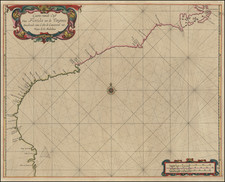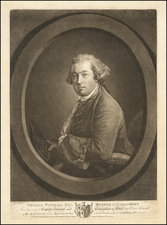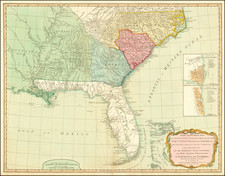Prepared By The Future Surveyor of the State of Georgia
Rare Early Georgia Plat, 9 Years After The Conclusion of the American Revolution by Daniel Sturges as Deputy Surveyor of Georgia, who would go on to become Georgia's State Surveyor.
The map illustrates a large tract of land on the south side of the Tugaloo River in what was then Franklin County, on the Georgia-South Carolina border.
The owner of the land, Thomas Gilbert, and one of the signatories, John Gorham, were 2 of the 33 Georgians elected to the Georgia convention which ratified the US Constitution.
The lands in question were the subject matter of litigation in later years when:
Robert Walsh and Stephen Casenave [filed a lawsuit against] Thomas Smyth, J r., John Blanton, John F. Gardner, Freeman Lewis, Thomas Gilbert, Benjamin Chew, John Heathcote, James Dall, Isaac Wikoff, James Clayland, William Cox, Joseph Anthony and Son, and the heirs of John Lynch . . . [claiming] that Smyth and Lynch, pretending to be entitled to a large quantity of land in the State of Georgia . . . [which] possess[ed] great advantages of water and navigation, and to be situated in an increasing, populous and wealthy country; and as evidences of . . . title . . . exhibited . . . a plot of a tract said to contain seventy-two thousand, seven hundred and fifteen acres of land, on Tooglo River, purporting to have been surveyed for Thomas Gilbert; one other plot of two adjoining tracts of land, the one said to contain sixty thousand acres, granted to John Blanton, on the 24th day of‘ March, 1794, and the other said to contain sixty thousand acres, granted to Freeman Lewis, on the same day; and a third plot representing a tract of land surveyed for John F. Gardner, and granted on the 21st of March, 1794, twenty-one thousand acres of which in his name, and the remaining part in the name of Thomas Gilbert, granted — day of——, 1795.
. . . A paper purporting to be a certificate given by Thomas Gilbert, on the 22nd of August, 1794, stating, that he had surveyed twenty-one thousand acres for John F. Gardner, on the 1st of August, 1793, in Franklin County, and that he believed the whole to be clear of elder surveys. . .
[The Plaintiffs employed] Jared Bull to go to Georgia, to inquire as to the title and quality of the lands . . . [Jared determined the claims were] fraudulently obtained upon forged warrants . . and that such parts of the said lands as were within Franklin County had been surveyed five or six years prior to the grants under which Smyth and Lynch claimed; and the whole were held and owned by divers citizens under lawful titles. That seventy thousand acres of the land in the said plot surveyed for Gilbert, was within the Indian Territory; and being beyond the line between the whites and Indians, no valid grant of it could be made by Georgia, without the assent of the United States, which had not been obtained . . .
Maryland Court of Chancery, Walsh v. Smith, 3 Bland, 1 (1824).
Franklin County, Georgia
Franklin County was created on February 25, 1784, the first county established in the state after the American Revolution (1775-83). William Bartram traveled through part of present-day Franklin County in 1773. At that time members of the Lower Cherokee Indian tribe lived there.
The original inhabitants of this Piedmont region were the Creek and Cherokee Indians. Over the years, the Creek and Cherokee Indians became indebted to the new settlers which led to the treaties of 1773 and 1783, where they relinquished claim over the land to the white settlers.
The Treaty of May 31, 1783, between the State of Georgia and the Cherokee Indians led to the development of the ninth county in Georgia, Franklin County. The original Franklin County encompassed parts of South Carolina and twelve counties in Georgia. The Treaty of Beaufort in 1787 that allowed the secession of the northern section of Franklin County to South Carolina.
Daniel Sturges is an important figure in early history of the state of Georgia.
Sturges was born in 1765 to the Reverend Daniel and Eleanor Sturges of Norborne Parrish, Virginia. The Sturges family migrated to South Carolina about 1789 and then to Georgia in 1790.
During the 1790s, the younger Daniel served as Deputy Surveyor General of the state and on January 26, 1797 was elected Surveyor General of Georgia. He served in this capacity for six terms until 1809 and was reelected by the Senate again in 1817, serving until his death in 1823 when his son Benjamin Hicks Sturges succeeded to complete his father’s term.
Besides submitting the winning drawing for Georgia’s Coat of Arms and Great Seal, Sturges also devoted twenty years to compiling the first detailed published map of the entire state.
Sturges administered the first four of Georgia’s six land lotteries, in 1805, 1807, 1820, and 1821, so he had a significant influence on the development of the state’s land policies. Sturges died at Columbia, South Carolina on September 17, 1823 (Cadle, 1991).









![Map of the States of North & South Carolina [Large Charleston Inset]](https://storage.googleapis.com/raremaps/img/small/91846.jpg)
![The State of South Carolina: from the best Authorities. 1796. [contemporary manuscript annotations]](https://storage.googleapis.com/raremaps/img/small/101052.jpg)


![[ Atlanta ] Mr. Gilmore's Official City Map of Greater Atlanta and Suburbs](https://storage.googleapis.com/raremaps/img/small/98689.jpg)
